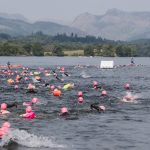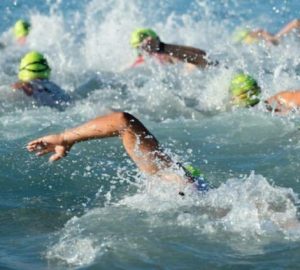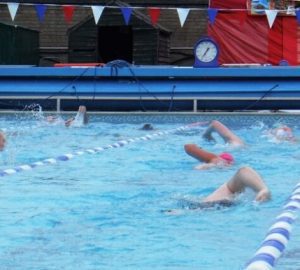
Master the two-beat kick
What’s the best front crawl kick pattern to use in open water – whether for pleasure or speed? Most swimmers have little familiarity with their kick or understanding of its role in propulsion. I was no exception. For 40 years, my legs fatigued each time I raced while adding precious little speed. I believed I needed to kick harder to swim faster, but doing so only disrupted my stroke rhythm while exhausting me. Decades of kicking sets did nothing to improve the functionality of my kick, nor minimize that ‘dead legs’ sensation.
There are two distinct kick rhythms in freestyle: the six-beat kick (6BK), with six leg beats per arm cycle (i.e. two strokes) and the two-beat kick (2BK), with just two beats per arm cycle. In both styles, only two beats contribute to propulsion through body rotation. In 6BK, the other four beats are preoccupied with body position and alignment.
The 6BK is unquestionably best for maximizing speed over distances of 100 metres or less. From 200 to 400 metres, either can be effective, depending on swimmer preference. As racing distance increases beyond 400 metres, the 2BK offers ever greater advantages in speed-for-effort.
The fastest distance swimmer ever, Sun Yang, uses both kicks to great effect. When he broke the 1500m world record in the 2012 Olympics, he used a 2BK for 90 per cent of the race before shifting up to a powerful 6BK in the final 150 metres. He used the 6BK exclusively in the 200m final, where he finished third. Given that, I believe a 2BK is the most efficient for virtually all distances and fitness levels in open water swimming
More speed, less work
If you’d like to swim faster with less effort consider adopting three priorities for your kick:
Priority One for your legs is to draft behind your upper body. Minimize kicking effort and focus on keeping legs within the ‘shadow’ of your upper body. You should quickly experience greater ease at any speed.
Priority Two is to connect your kick to core power and minimize the burden on your thigh muscles. Your quadriceps tire easily and consume energy lavishly, with most of it spent simply churning the water into froth. Feel that each leg beat results from arm extension and torso rotation, not from working your leg muscles. Also, strive to feel the pulse of each leg beat in your abs, not thighs.
Priority Three is to use pressure from shin and foot to help arm extension and core-body rotation. This requires you to use head, arms and upper body (instead of the kick) as the primary tools for maintaining good body position. (Note: If you haven’t balanced your body and stabilised your core, most leg action will be diverted to compensating for those skill deficits.)
Timing is everything

The right hand has just entered the water, the left hip is down and left foot is up, ready to kick. Both feet are in the shadow of the body.
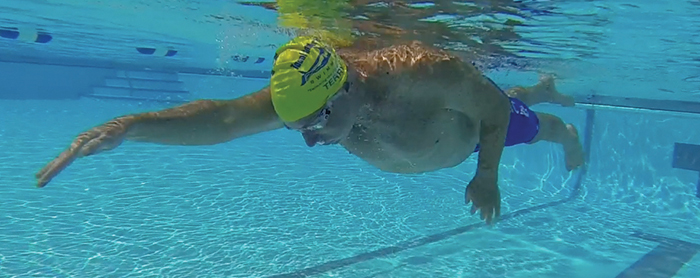
The left foot has now driven the right hand to full extension and the hips have rotated.
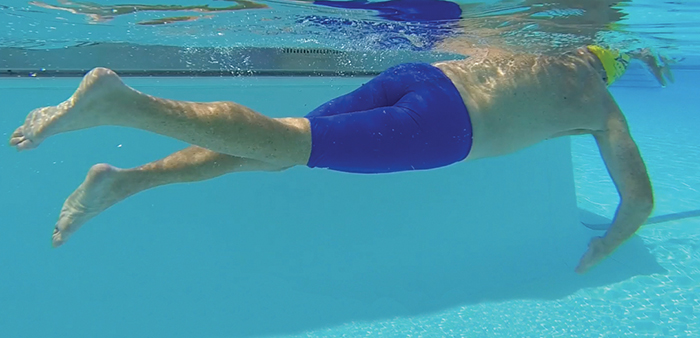
The left hand has just entered the water, the right hip is down and right foot is up, ready to kick. Both feet are in the shadow of the body

The right foot has now driven the left hand to full extension and the hips have rotated.
Master the two-beat kick
1. Calm Your Kick
If your kick feels ineffectual or tiring, you probably have ‘busy’ legs: churning, bending, splaying. Your first step is to quieten wasteful, disruptive actions by creating a balanced, stable body position (using a gliding exercise), then maintain these new sensations when you return to full stroke.
Superman – Glide with arms extended at shoulder width. ‘Hang’ your head between your shoulders. Hold streamlined legs lightly together. If your legs sink, counter the instinct to churn them. Let them go. Then stand for a breather and push into Superman again. Repeat four to eight times, trying to slightly increase glide distance with more practice.
Swim – Try some whole-stroke reps. Begin each with a brief Superman glide, imprinting a weightless head and streamlined legs. Segue smoothly into four to six non-breathing strokes. Feel your legs separate as you reach forward to begin stroking. Feel that your legs follow your body and its movement while minimizing overt or unconnected leg action.
2. Streamline Your Kick
Streamlining is a bit more advanced than calming. Visualise the slipstream behind your upper body. Try to keep your legs within that slipstream and sense when they drift outside it. If you feel that occur, excess hip rotation or a wide-swinging recovery are likely causes. Control those and you’ll also control your legs.
3. Tune Your Kick
In this step, you reintroduce an intentional kick, but aim for a small, light toe-flick rather than a leg drive. Synchronise right-foot-flick to left-hand-entry, and vice versa. A Tempo Trainer can help. Set the trainer at a moderate tempo (1.2 sec/stroke or slower), then synchronise your toe-flicks to the beep. Notice if there are unconnected movements between beeps. Work patiently at eliminating them.
Try this now . . . This rehearsal will help you sense how upper body, hips and feet work together in a 2BK. Stand in bare feet on an uncarpeted floor, or on a pool deck. With your weight on the balls of your feet, rotate your ankles in parallel. Hips and tops of feet will face left together, then right, just as they should when swimming with 2BK. Then add a simulated stroking action. Extending your right hand rotates the hips to left and thus puts left foot slightly in front of right. This is the equivalent of a left-toe flick synchronised with right-hand extension.
Learn faster
- Allow several weeks each for calming and streamlining before attempting to tune your kick.
- Begin with super-short repeats – just four to six strokes – without breathing. Stop for a rest and reset whenever you feel your legs reverting to old habits.
- Progress gradually (one stroke cycle and one breath at a time) to 25y/m reps. Swim only as far as you can feel the sensations described. Begin longer repeats with four to five non-breathing strokes, then breathe as needed.
- Start reps from a Superman glide, rather than a regular push-off. Feel effortless travel with ‘quiet’ legs, before you begin stroking.






